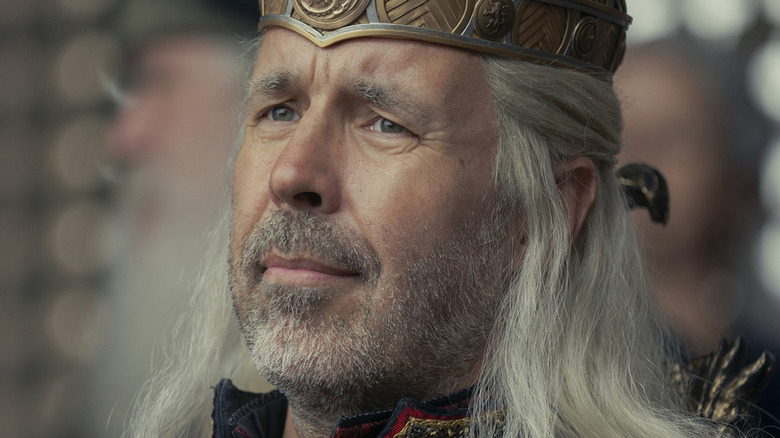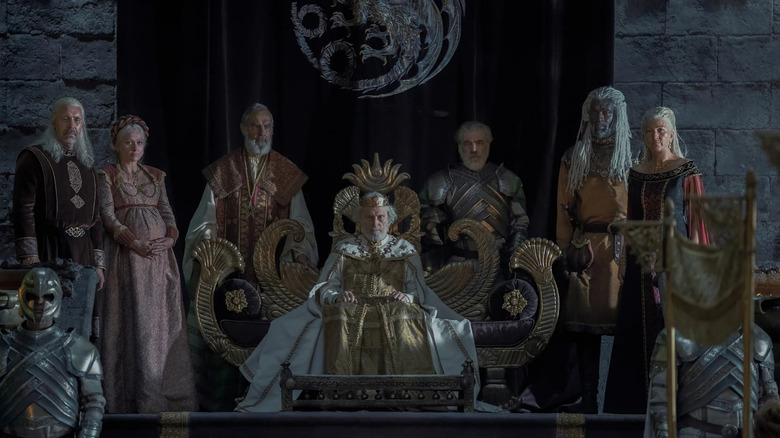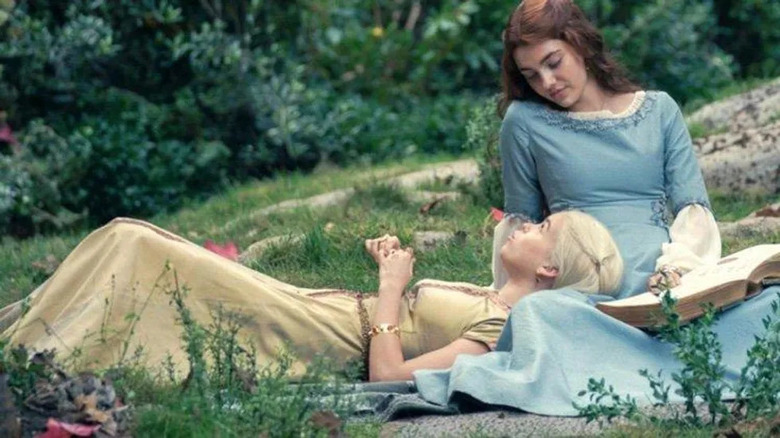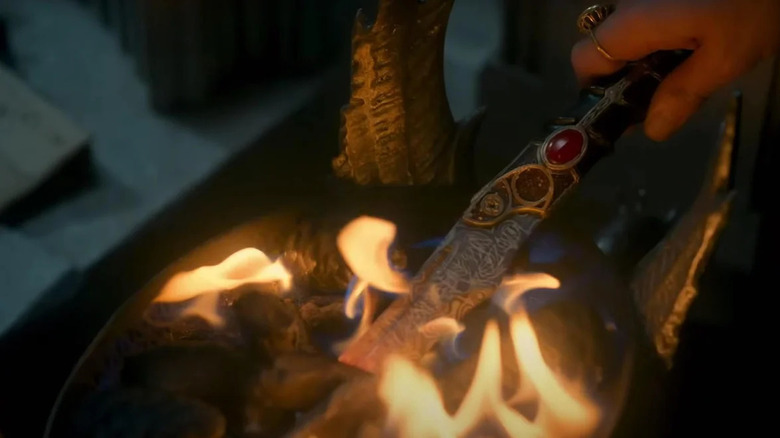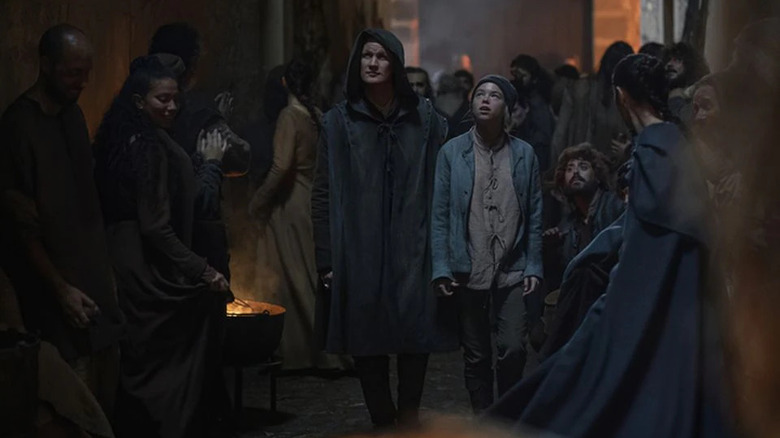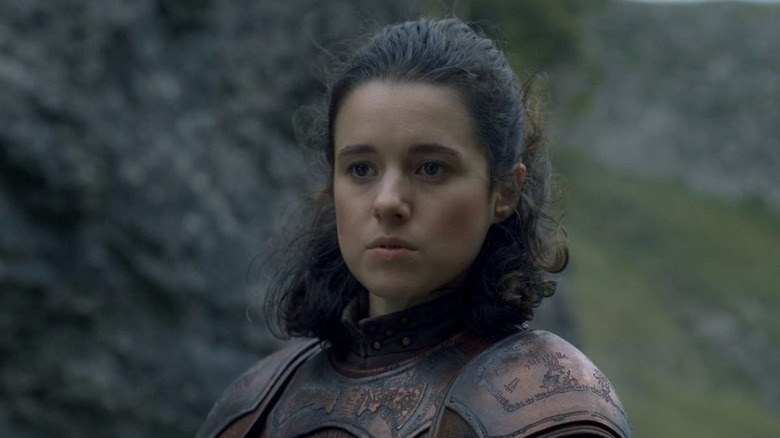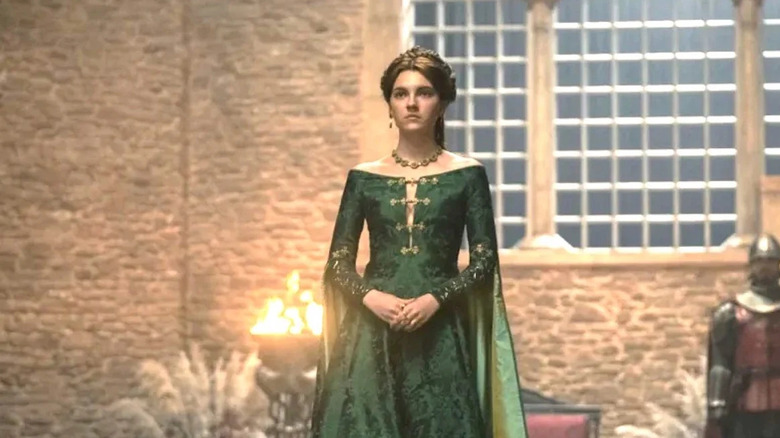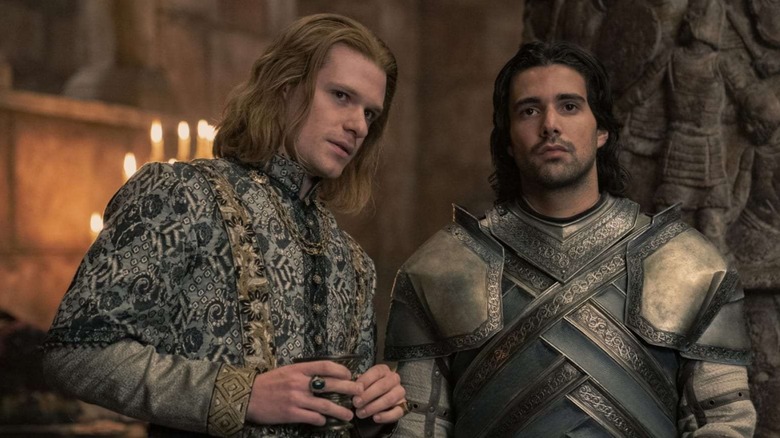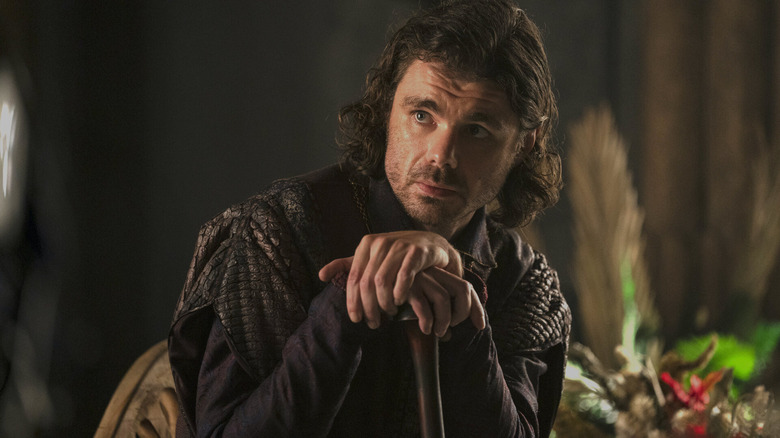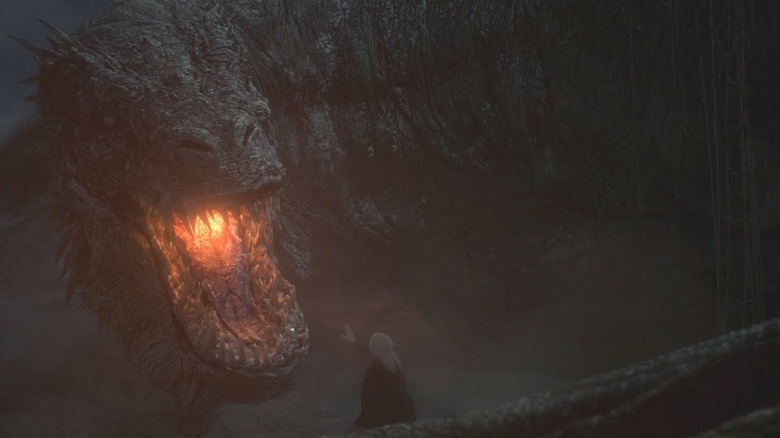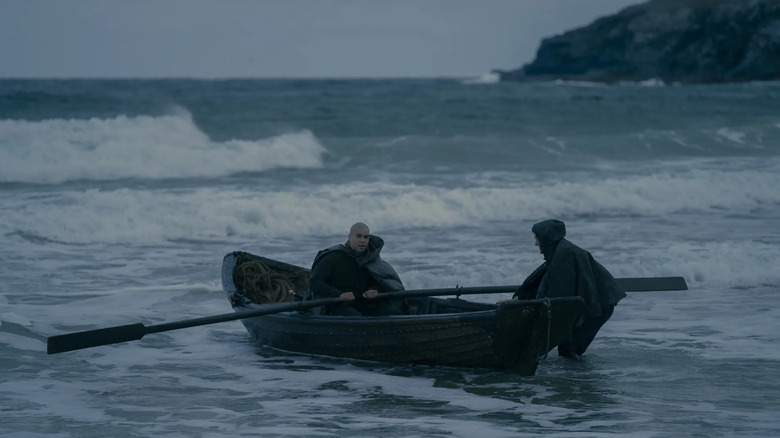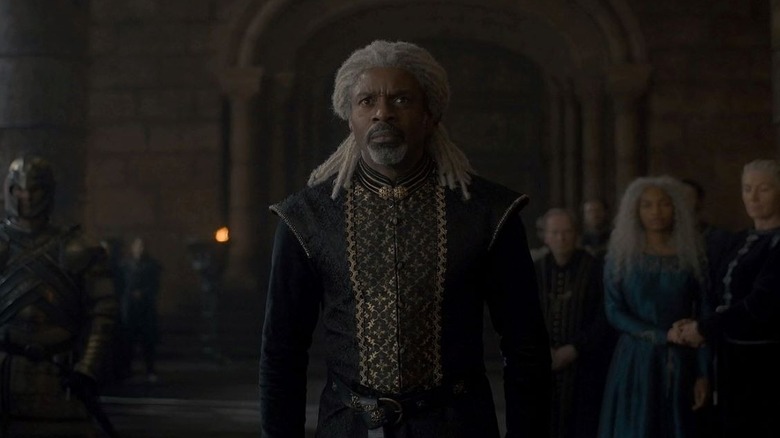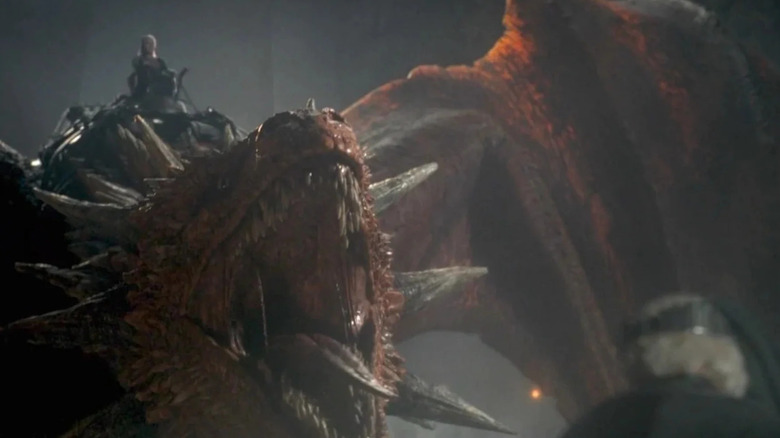All The Major Differences Between Fire & Blood And House Of The Dragon
Like "Game of Thrones," HBO's "House of the Dragon" is based on the writing of George R.R. Martin. Both shows explore the fantastical fictional world of Westeros, and both are similarly provocative, but "Fire & Blood" is an entirely different beast compared to Martin's still-unfinished "A Song of Ice and Fire" saga. The latter, which inspired "Game of Thrones," is a series of novels told in the third person from the perspective of a rotating cast of main characters including Ned Stark, Tyrion Lannister, and Daenerys Targaryen. It covers about seven years of Westeros' tumultuous timeline and gets deep into the psychology of the various players vying for the Iron Throne.
"Fire & Blood" — the first half of which was released in 2018 — is intended to span nearly 200 years of Targaryen history, and is told by unreliable narrators and secondary sources. It moves fast ("House of the Dragon" is based on only a few chapters) and is purposefully surface-level the way a textbook might be. While "Game of Thrones" writers had to condense long passages into short TV scenes, "House of the Dragon" writers had to fill in the blanks. In some cases, that means expanding a sentence into an entire plot arc (like the Crabfeeder, for example). In others, it's meant providing a character with motivations or abilities the source material doesn't give them.
The Targaryen-focused prequel follows the book's main events pretty closely, albeit with a few notable exceptions. These are the creative liberties "House of the Dragon" has taken so far. Spoilers ahead.
The Great Council of 101 AC
"House of the Dragon" roughly covers the second half of "Fire & Blood," and the show wisely chooses an event called the Great Council of 101 AC as its starting point. In a brief prologue, adult Rhaenyra explains the situation via voiceover. After 60 years on the Throne, King Jaehaerys was near death. Tragedy had befallen his sons, so the question of his succession was brought before a thousand Lords of the Realm. "14 succession claims were heard but only two were truly considered: Princess Rhaenys Targaryen, the king's eldest descendant, and her younger cousin, Prince Viserys Targaryen, the king's eldest male descendant," she says. The Lords chose the man.
Later in Episode 1, Rhaenys is called the "Queen Who Never Was." She's called this in the book, too, but not because she was denied the Crown at the Great Council. In "Fire & Blood," Queen Alysanne wants Rhaenys to be named heir when her father, Aemon, is killed in battle in 92 AC. Jaehaerys names Aemon's younger brother Baelon as Prince of Dragonstone instead, which causes an estrangement between the king and queen that lasts two years, dubbed "the Second Quarrel."
When Baelon dies, Jaehaerys holds the Council to decide between two male claimants: Laenor Velaryon and Viserys Targaryen. Laenor has the stronger claim and a dragon, but he's only seven years old. Viserys is in his 20s and already living at King's Landing, so he wins the vote. "House of the Dragon" highlights the misogyny in Martin's historically-inspired fantasy world, so swapping Laenor for Rhaenys makes thematic and narrative sense.
Rhaenyra and Alicent's friendship
In "House of the Dragon," we meet Princess Rhaenyra and Alicent Hightower as girls of about 14. They're best friends and constant companions, and the actors who portray them even imbued their relationship with some sexual ambiguity. That innocent friendship gets complicated when Hand of the King Otto Hightower coerces his daughter into seducing Viserys after the death of his wife Aemma in childbirth. When Viserys proclaims he'll take Alicent for his second wife, Rhaenyra considers it a betrayal. When the new queen gives the king the sons he never had with Rhaenyra's mother, it leads to all-out war.
The relationship between Rhaenyra and Alicent doesn't exist in the book, mostly because Alicent is a decade older than Rhaenyra in "Fire & Blood." She's not overtly religious as she is in the show, either. Rather, she's more of an Anne Boleyn figure whom Otto Hightower has kept at court since the waning days of King Jaehaerys, hoping to use his pretty daughter to advance his family's position. Alicent is said to have "read" to Jaehaerys (which could be a euphemism) and to have bathed and dressed him. She was even with him when he died.
In the book, she's rumored to have slept with Daemon and possibly even Viserys while Aemma was still alive. Shortly after he's widowed, Viserys chooses Alicent to wed because of her beauty. The 18-year-old stepmother and her 9-year-old stepdaughter get along well enough. That is, until she gives birth to Aegon and Aemond and Viserys refuses to revisit his succession. Book Alicent is less well-drawn and definitely less sympathetic.
Aegon's dream and the Catspaw Dagger
An infamous "Game of Thrones" prop unexpectedly popped up in the premiere episode of "House of the Dragon" and became even more important to the established lore... at least the version that airs on TV. After Viserys names Rhaenyra his heir, he lets her in on a family secret. Their ancestor, Aegon the Conqueror, was a dreamer. One of his visions warned of a threat from the North and the need to keep a Targaryen on the Iron Throne to defend the Seven Kingdoms against its coming. He called this dream his Song of Ice and Fire, and he etched it into the blade of his Valyrian steel dagger. The inscription can only be read once it's put to a flame.
In Episode 8, Rhaenyra asks her dying father if he believes Aegon's dream. As heir, she needs to know whether she may face a cataclysm as deadly as the Doom. He's not well enough to answer at the time. But in his last conscious moments, he mistakes his wife for his daughter and tells Alicent about the dream. Viserys insists Rhaenyra's line must rule, but Alicent misunderstands and thinks he means their son Aegon.
Aegon's prophecy and the Catspaw Dagger are both show inventions. The dream and the dagger provide additional motivation for Aegon I to have conquered the Seven Kingdoms, and for every Targaryen thereafter to have governed as they did. There is no such motivation in the print version, nor is there a misunderstanding before Viserys dies. Alicent seizes power simply because she wants to.
Rhaenyra's night out
One of the most intriguing aspects of "Fire & Blood" is that the reader can never be sure if what they're reading is true. It's composed in the style of a history textbook and relies on secondary sources. In contrast, "House of the Dragon" provides viewers with its own definite account.
Case in point: In the show's version of Rhaenyra's scandalous youth, the princess is escorted out of the castle and through the Street of Silk by her uncle Daemon. They end up at a pleasure house where Daemon tries to teach her that marriage is only a political contract and that people can do whatever they want in places such as these. He considers deflowering her, but stops. A sexually awakened Rhaenyra runs home and practically orders Ser Criston Cole to go to bed with her. Mysaria sends word to Otto that Daemon and Rhaenyra were seen "coupling," and Daemon offers to marry Rhaenyra, though the king doesn't consent.
The show's version is a hybrid of two possible sources from the book. One, Septon Eustace, claims that a knight named Arryk Cargyll caught Rhaenyra and Daemon in bed together, and that the pair were in love and wanted to marry, but the king forbade it as Daemon already had a wife: Lady Rhea Royce. Another source, the court jester Mushroom, holds that Rhaenyra loved Ser Criston and kept her virginity for him, but otherwise learned how to please a man from Daemon and from trips to brothels over a period of months. When she attempted to use her newfound skills to seduce him, Ser Criston was "horrified and spurned her."
Lady Rhea Royce's death
"House of the Dragon" introduces us to the effortlessly cool Lady Rhea Royce in Episode 5 — then kills her off within seconds. Daemon had previously spoken disparagingly about his wife, describing the women of the Vale as, shall we say, less attractive than sheep. The prince and the Lady of Runestone's marriage was arranged without their input. But when the audience meets Rhea, she's not only beautiful, she's confident and a skilled hunter... qualities that Daemon ought to appreciate.
It's implied that Daemon struggles with impotency and that perhaps his relationship with Rhea soured long ago as a result. The Rogue Prince finds her alone and startles her horse. The animal rears up and falls on its back, crushing its rider. Rhea is conscious but paralyzed. She taunts him one last time — "I knew you couldn't finish" — and calls him a craven, prompting him to pick up a rock. We don't actually see him put her out of her misery, but a head injury is later reported to the king.
In "Fire & Blood," Rhea does die at the same point in the story after she falls from her horse. She's said to have cracked her skull upon a stone, but she survives for nine days. Book Daemon has an alibi (he's still fighting in the Stepstones) and Rhea never names an assailant. Many readers still find her death suspicious, though, and wonder if Daemon was involved somehow. Little else about Rhea besides Daemon's scathing opinion of her is in the text, and there's no suggestion of Daemon's sexual dysfunction (in fact, it's quite the opposite).
The Green Wedding
In both the book and the series, King Viserys Targaryen's blended family is split into factions that become known as the Blacks and the Greens. The why is the same — Otto, Alicent, and half the Realm want Aegon instead of Rhaenyra for the heir — but the how, when, and where are all different.
"Fire & Blood" tells of a great tournament held to commemorate Viserys and Alicent's fifth wedding anniversary in 111 AC. At the welcome feast, Alicent wore a Hightower green gown while Rhaenyra wore Targaryen red and black. The significance of their fashion choices did not go unnoticed, and people began organizing into two camps supportive of either the queen or the princess. In the book, this tourney is also when Daemon returns from the Stepstones to present Viserys with his Narrow Sea crown, and it predates Ser Criston Cole's fallout with Rhaenyra. He wears her favor and wins the tournament for the Blacks, unhorsing Alicent's brother Gwayne Hightower.
"House of the Dragon" unveils Alicent's famous green dress at the welcome feast for Rhaenyra and Laenor's wedding, when the princess is clad in white. The series is less specific about its timeline, but the wedding happens about six months to a year after the anniversary party would've occurred. We get no such anniversary celebration on screen; it might've felt repetitive to have multiple tournaments and multiple feasts in Season 1, and the plot likely had to be condensed for narrative efficiency. Still, book readers were robbed of the dramatic moment in which these two women go to war with their respective fashion statements.
Joffrey's murder
It's a relatively open secret that Laenor Velaryon is in love with his protector, Ser Joffrey Lonmouth, the Knight of Kisses. Rhaenyra seems to sense as much when she uses the metaphor of preferring duck to goose to propose an understanding between them upon their betrothal (in the book, Grand Maester Mellos says, "I do not like the taste of fish, but when fish is served, I eat it," to describe how Laenor and Rhaenyra's marriage might work).
In "House of the Dragon," Laenor and Joffrey agree that his union with Rhaenyra is the best outcome they could've hoped for, especially once the observant Joffrey notices Ser Criston struggling to watch Rhaenyra on the dance floor. Laenor and Joffrey, who go so far as to nuzzle each other in public, decide to let Criston in on their secret arrangement. They don't know the knight had asked the princess to run away with him to Essos... an offer she politely turned down to fulfill her sovereign duties (according to one source, she's less polite about it in the book). An enraged Criston beats Joffrey in front of the guests and, curiously, never faces any consequences.
Criston Cole does kill Joffrey Lonmouth in "Fire & Blood," but under much more justifiable circumstances. At a tournament following the wedding (Book Viserys loved his tourneys), Ser Harwin rode for Rhaenyra, Ser Joffrey rode for Laenor, and Ser Criston rode for Alicent. In competition, Criston smashed in Joffery's helm with his morning star and knocked him unconscious. He lived another six days, during which newlywed Laenor stayed by his side, but he never woke.
Arson at Harrenhal
Martin's stories are never in need of traditional villains, but "House of the Dragon" has given us a particularly twisted character in Larys Strong. As opposed to the Hightowers, who engineered their rise, the Strongs have made themselves indispensable to the Targaryens on their merits. Lyonel is as wise and impartial a Hand as any king has ever had. Harwin, who becomes Commander of the City Watch, is a loyal and loving partner to Rhaenyra and father to his three children, though he can't even claim them as his family. Larys is good at what he does, too, as Queen Alicent soon finds out. It's just that what he does well is spy, torture, and contract kill.
In Episode 6, after Harwin assaults Criston for harassing the princes, Lyonel tries to step down, but Viserys won't accept his resignation. Alicent wants Lyonel out of the way so her father can return and reclaim his pin, but she doesn't explicitly ask Larys to do what he does next. He commutes three prisoners' sentences so long as they'll do his bidding, but first, he cuts out their tongues. They torch the castle with Lyonel and Harwin inside. Legends that Harrenhal is cursed are enough to cover up the crime.
Book Lyonel and Harwin die in a blaze at Harrenhal, too, and no one is officially blamed. However, four possible suspects are mentioned. Daemon may have done it out of jealousy. Corlys may have done it out of anger that his grandsons were clearly Strongs. Larys may have done it, though his motives remain a mystery throughout "Fire & Blood." Finally, Viserys himself could have set the fire to put a stop to the gossip.
Vhagar
Since "Fire & Blood" begins generations before the Dance of the Dragons, readers get to know Vhagar — the oldest and biggest living dragon in Westeros — when she belongs to Visenya Targaryen, sister-wife of Aegon the Conqueror, and flies alongside his mount, Balerion. By the time Viserys takes the Throne, Balerion is a skull in the catacombs and Vhagar is riderless. But she doesn't stay that way for long.
On the show, 12-year-old Laena asks King Viserys about Vhagar. Two time jumps later, Laena has claimed Vhagar (and Daemon) for herself. When she realizes she won't survive her labor, she crawls to Vhagar and screams "dracarys," and the dragon reluctantly puts an end to her suffering. At her funeral, young Prince Aemond — who doesn't have a dragon yet — sneaks out at night and climbs into Vhagar's saddle. He survives his test ride, and she follows him when the Royal Family departs Driftmark for King's Landing.
Book Laena has already claimed Vhagar when she's floated as a possible wife for Viserys, and her love of riding dragons is her defining characteristic. She dies after she gives birth, trying to ride Vhagar one last time. The most significant change to the text is that her daughters aren't there when Aemond steals Vhagar and is confronted by Jace and Luke. In this case, the show's version — which adds Baela and Rhaena to the mayhem — is more meaningful. Aemond making off with Vhagar not only adds to Rhaena's grief and frustration (her egg still hasn't hatched), it strengthens the bonds between Jace and Baela and Luke and Rhaena.
Laenor's escape
The most radical change "House of the Dragon" has made to the source material thus far is the fate of Laenor Velaryon. Up until a certain moment, show Laenor is much like book Laenor. He and Rhaenyra have a marriage of convenience in which she can be with Harwin Strong and he can be with his new knight in shining armor, Qarl Correy.
In Episode 6, Rhaenyra and Laenor leave King's Landing for Dragonstone after they conclude that the Greens (as well as persistent rumors) will continue to torment them. Harwin has already been stripped of his commandership and sent back to Harrenhal, but Rhaenyra tells Laenor to bring Qarl, ostensibly because she needs every sword she can muster, but also because she knows Qarl makes Laenor happy. In the next episode, after Rhaenyra and the recently widowed Daemon finally consummate their long-simmering relationship on the beach, they discuss the inevitable. Her current husband will have to die in order for them to "burn together."
Despite some trick editing, that's not what happens. The four interested parties — Rhaenyra, Daemon, Laenor, and Qarl — stage a fight between the male lovers in front of witnesses. When the onlookers run for help, the schemers plant a body in the fireplace, then Laenor (with a shaved head) and Qarl escape in a rowboat. In "Fire & Blood," Qarl kills Laenor at a crowded market in Spicetown. One account suggests Qarl drew his sword out of jealousy, believing Laenor had taken up with a younger man. Another puts forth — without proof — that Daemon bribed Qarl to slay Laenor so he could wed Rhaenyra. Either way, book Laenor is definitely dead.
Vaemond's brutal punishment
What happens to Vaemond Velaryon in Episode 8 of "House of the Dragon" is pretty ghastly, but it could've been worse. With Corlys barely clinging to life, Vaemond tells Rhaenys that he intends to petition the Crown to become the next Lord of Driftmark. Though Alicent, Criston, Aegon, and Aemond had spoken openly about the alleged Strong boys before, only Vaemond had the guts to do it at court in front of the king. Having been denied the Driftwood Throne, he shouts that the boys are bastards and that Rhaenyra is a whore.
Viserys had previously threatened to cut out the tongue of anyone who gossiped about his daughter in such a way, and in response to Vaemond's treason, the ailing king stands and readies his dagger. Daemon beats him to it, delivering swift justice with Dark Sister, slicing the top of Vaemond's head off and leaving his attached tongue flapping on the floor. What could possibly be worse than that?
In "Fire & Blood," Rhaenyra orders Daemon to behead Vaemond, then she feeds his carcass to her dragon, Syrax. But that's not all. Vaemond had five cousins who backed up his claim to the throne and repeated the rumors about Jace, Luke, and Joffrey. Book Viserys goes one step further and cuts out their tongues after Vaemond is turned into dragon food, a warning to anyone else who would dare to question the legitimacy of his succession.
Captive Rhaenys
The Greens are able to usurp the Iron Throne because Rhaenyra has left King's Landing and is thus unaware of the king's death. To keep word from getting out, Alicent and Otto imprison the servants who know along with the lords who won't bend the knee. But in the show, Alicent must also lock Rhaenys in her room to prevent her from alerting Rhaenyra and because the dragon math doesn't add up in her son's favor. The Greens have Vhagar plus Aegon's Sunfyre and Helaena's Dreamfyre. The Blacks have Syrax, Caraxes, Moondancer, Vermax, Arrax, Meleys, Seasmoke, and a few riderless dragons to boot.
Harrold Westerling and Erryk Cargyll defect to the Blacks (in the book, Ser Harrold is long dead by this time) and the latter frees Rhaenys from her quarters. They're parted by the masses of people assembling in the Dragonpit for Aegon's coronation. Rhaenys, in full armor, re-emerges mid-ceremony atop Meleys, who roars at the Greens. It's quite an awesome sight. They fly off together, presumably to inform Rhaenyra.
This sequence of events is unique to "House of the Dragon." In the book, Alicent and Otto hide the king's decaying body for a week and conspire for nine days to put Aegon on the throne. Rhaenys isn't in the Red Keep following the king's passing, nor is Meleys in the Dragonpit, and the proceedings go uninterrupted. What about the huge crowds of people gathered for the ceremony? One source claimed that more than 100,000 people filled the Dragonpit to celebrate the crowning of the new king that day, while another said that it was only half full.
